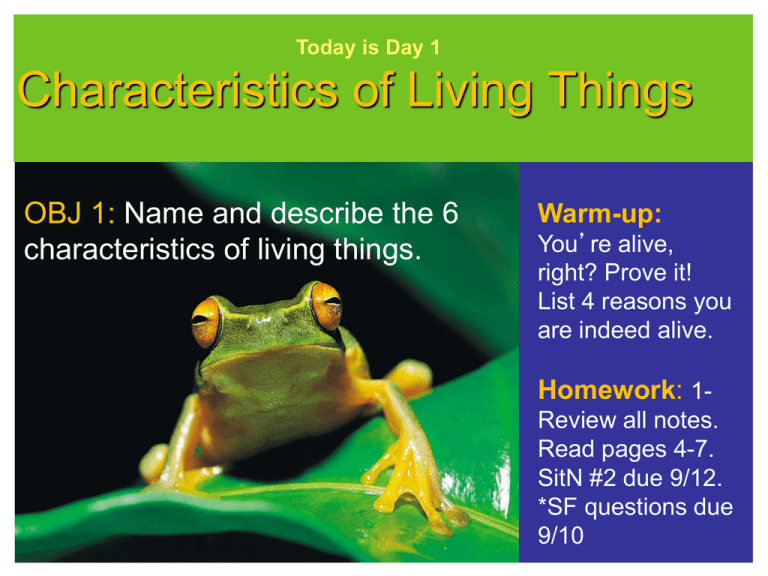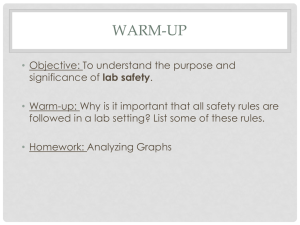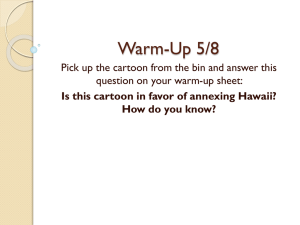9.15.10 Characteristics of Living things
advertisement

Today is Day 1 Characteristics of Living Things OBJ 1: Name and describe the 6 characteristics of living things. Warm-up: You’re alive, right? Prove it! List 4 reasons you are indeed alive. Homework: 1Review all notes. Read pages 4-7. SitN #2 due 9/12. *SF questions due 9/10 Agenda 1. Characteristics of Life Challenge! * What characteristics determine if you are living or nonliving? (10 minutes. Discuss with a partner.) 2. Research in groups 3. Presentations. Draw! Get a piece of paper and divide into 6 sections. Draw a pictorial representation of each characteristic of life. 4. Conclusion: Name 3 characteristics of life. The Challenge! Task: Make 2 lists; one, listing characteristics of the living and one, listing characteristics of the non-living. Goal: To determine the *6 characteristics of living things. Hint: try to answer… • It may help to compare specific organisms. For example, a spider and a lion. What characteristics do these organisms share? How do you KNOW they are alive? • Think of two things that are not living. How do you KNOW they are not alive? 6 Characteristics • You will be divided into 6 groups. • Research your characteristic via the web. You must use & provide the class with at least two credible sources and become an expert on your topic. Share your expertise with the class. • In 10-15 minutes we will begin presentations. • YOU are responsible for all that is said. Conclusion • Name 3 characteristics of living things. Today is Day 2 Characteristics of Living Things OBJ 1: See yesterday. Warm-up: Is a rock alive? Why or why not? Homework: *Possible QUIZ on OBJ 1 Agenda • Finish presentations • Notes Youtube. http://www.youtube.com/watch?v=rt8gpsbMXE There are more actually. Pay attention to the following. 1. Living Things Have Cells • Unicellular organisms • Multicellular organisms (can have specialized cells) 2. Living Things Sense & Respond to Change • Stimulus: a change in an organism’s environment that affects the activity of that organism • Chemicals, gravity, light, sound, taste 3. Homeostasis • Organism must maintain a stable internal environment to survive • Sweating. . . shivering 4. Living Things Reproduce • They need to keep making themselves so they carry on the species! • Asexual reproduction: Single parent produces offspring IDENTICAL to the parent. • Sexual reproduction: Almost always requires 2 parents to produce characteristics of BOTH PARENTS. 5. Living Things Have DNA • Deoxribonucleic Acid = DNA • It provides instructions for making proteins • DNA = Heredity 6. Living Things Grow & Develop • Single cell--> Cells grow larger • Multicellular--> Grow by increasing the # of cells • What is the difference between growth & development? Apply it! • Why is a . . . . alive / non-living: • Dog • Mosquito • Rock • Water • Algae HINT: You have 6 reasons for why/how living things are living. Use one! Conclusion • How do humans maintain homeostasis? Today is Day 3 Characteristics of Living things OBJ 2: Explain why organisms need food, water, air, & living space Warm-up: Now that you know the 6 characteristics of life, what do you … think are an organism’s basic needs? Homework: Read OBJ 3: Discuss how living things obtain what they need textbook A pages 8-9 and take notes. Agenda • Quiz • Review notes • Presentations Youtube. http://www.youtube.com/watch?v=rt8gpsbMXE There are more actually. Pay attention to the following. Conclusion • Describe what it means to be made up of cells. What are the bare necessities of life? Warm-up: Today is Day 4 Complete Section Review on page 9. Homework: Read textbook pages 10-13 in textbook A. Take notes! OBJ : See yesterday’s objectives. To do • Presentations • The Bare Necessities • Notes • How living things adapt: discussion • Nature vs. nurture? • Producers, consumers etc. activity explanation The Bare Necessities of life Today is Day 5 Warm-up: Finish answering SR questions on page 9. Take out SF Timelines. Homework: 1- OBJ : See previous objectives. Bring in 2 nutrition labels 2- Bring in 1 picture of either a producer, consumer, decomposer OR scavenger. To do • Presentations • The Bare Necessities • Notes • How living things adapt: discussion • Nature vs. nurture? • Producers, consumers etc. activity explanation Bare Necessities What are the bare necessities to life? (what is the bare minimum an organism needs to live? Does that change for humans? • http://www.youtube.com/watch?v=Tcgln Y_xGfc Food • Why do we need it? Brainstorm • Producers • Consumers • Decomposers • Scavengers • What do these mean when it comes to living organisms? Water • Why do we need it? Air • Why do we need it? Habitat • Why do we need it? How do living things adapt to… Cold temperatures? Warm temperatures? (changes in the environment) Competition for resources- food/ water/ shelter? Mates? Nature vs. Nurture • We inherit characteristics from both our parents. Scientists continue to study whether or not we get our personalities from our parents. What do you think? Conclusion • How do producers, consumers, decomposers and scavengers help one another to achieve their bare necessities? The Bare Necessities of life Warm-up: none Today is Day 6 Homework: 1Be sure to review all of your notesQUIZ is coming! OBJ : See previous objectives. See objectives 1-3. Agenda • Research • Categorize pictures • Gallery walk • Begin The Chemistry of Life introduction IF TIME! • Begin homework Research • See “Big Question” handout. Complete chart. Task • Categorize each item your group members brought in, next discuss/ plan how each trophic contributes to the “bare necessities” of life. Conclusion 1. Give an example of a producer, consumer, and decomposer. 2. What factors affect where a plant or animal lives? Bare necessities 4 Today is Day 7 Warm-up: Name the 5 molecules that create the “chemistry of life”. Homework: Create a Creature project. (I will explain/ review rubric.) Project due See objectives 1-3. Thursday, Sept. 18th. Review pages 4-13. Chemistry of Life • Let’s begin! To Do… • Explain your homework • Finish research • Posters= concept map: • • Create a Concept Map - Create a concept map of using the pictures you brought in! • Use the following terms: Photosynthesis, producers, primary consumer(s), secondary consumer(s), tertiary consumer(s) (IF applicable) and decomposer. Gallery walk Create a creature Project • Zookeeper. You are a zookeeper creating a new exhibit. You must inform the visitors about your newly discovered animal. • Make up an animal. Using EACH of the 6 characteristics of life & the 4 bare necessities, describe how the animal is alive & functions in the environment ... See RUBRIC!! Example 1. Name of your animal (and drawing) 2. Unicellular or multicellular? 3. How does it respond to its environment? 4. How does it reproduce? 5. How big does it grow? How does it develop into an adult? 6. What does it eat? (and how does it get its food?) 7. How does it use energy? 8. Where does it find water? 9. What does it breathe? 10. Where does it live? Describe its habitat. BuT firsT… • What is the difference between a food web and a food chain? • See the following: http://www.flyingwild.org/documents/74. pdf http://www.slideshare.net/sth215/produc ers-consumers-and-decomposers conclusion • What factors affect where a plant or animal lives? The chemistry of life 1 Today is Day 8 Warm-up: none Homework: Creature project due 9/18. SitN #3 due 9/19. Review notesQUEST on 9/18. OBJ 4 : Compare and contrast1-3. the See objectives chemical building blocks of cells. Agenda • Continue research/ food web or food chain. • Gallery walk- take notes • Chemistry of Life The chemistry of life 2 Today is Day 9 Warm-up: Answer these two questions. Homework: 1. Creature project due ______. 2. TEST _______. Complete Ch. Review #1-12 OBJ 4 : Compare and contrast the See objectives 1-3. chemical building blocks of cells. Agenda • Food web / food chain • Gallery walk- take notes • Chemistry of Life So really, what is a cell? • a membrane-covered structure that contians all of the materials necessary for life • found in all organisms • sometimes specialized for particular functions Chemical Building Blocks • Proteins- amino acids • Carbohydrates (starch)- sugar • Lipids- fats & oils • Nucleic Acids (DNA) - nucleotides • The cell’s fuel: ATP Draw this chart in your notes Carbohydrates Subunit Function in organism At least 2 other facts Proteins Lipids Nucleic Acids What you need • Name of building block • The subunit (it’s smallest unit) • Its function in an organism • Any other facts Research-Focused Read Method *You need a highlighter, a pen or pencil and your binder to take notes 1. See the following articles or site. http://www.chem4kids.com/files/bio_carbos.html 2. You will be a assigned a particular article to read. Once you’ve finished reading complete the chart in your notes. 3. Share your research with your group- you are responsible for all information shared! 4. At the end, we will review our findings! Conclusion • Based on what you know about carbohydrates, lipids, and proteins so far, why is it important for you to eat a balanced diet? Today is Day 10 The Chemistry of Life 3 OBJ 4: Compare and contrast the chemical building blocks of cells. OBJ 5: Explain the importance of ATP. OBJ 6: Analyze nutrition labels according to the chemical building blocks of life. TURN IN SF FINAL QUESTION! Warm-up: Complete Section Review on textbook page 13. Check. Homework: Creature projects due 18th. QUEST on 9/18 Science in the News #3 due 9/19.. To Do • Finish Focused Read/ share research • Review • TIME PERMITTING: Read/ do QuickLab on page 11. Starch. Research Focused Read: • continue reading articles • share with your group • begin filling in your chart Conclusion • What is the subunit of a carbohydrate? A protein? A lipid? Chemistry of Life 4 Today is Day 11 Objectives are the same. Warm-up: Turn in “Create a Creature” project- place in class bin. Homework: Labels activity- I will explain!! Review notesQUEST on Thurs. (9/18). To Do • Wrap up research • Class Share • Building Blocks cheat sheet • Notes Homework Activity • Using foods eaten either for lunch or dinner: 1- Identify your favorite items (top 3) 2- List their total carbohydrates, fats, proteins and calories per serving. Carbohydrates • GRAMS • Monosaccharide • Group of compounds made of sugars • Cells use carbs as a source of energy and for energy storage • Simple (few sugar molecules) & complex carbs (many sugar molecules) Proteins • Amino acids (subunit)- GRAMS • Almost all cell processes involve proteins (most abundant material in cells after water) • Break down food into amino acids to supply to cells • Help protect us, chemical reactions faster Lipids • Fats & oils (subunits)- GRAMS • Compounds that CANNOT mix with water • Some store energy • Stored as fat in animals. Oils in plants • Phospholipds: molecules that form much of the cell membrane Nucleic Acids • Nucleotides (subunits) • “blue prints of life” • DNA is a nucleic acid. (Deoxyribonucleic Acid) • “Recipe Book for proteins” ATP • Adenosine Triphosphate • Major fuel used for all cell activities that require energy • When carbs &lipids are broken down, they release ATP Conclusion If you went to Mars, what kinds of evidence would you look for to prove that life once existed there? How could the discovery of nucleic or amino acids prove life existed on Mars? Chemistry of Life 5 Today is Day 12 Warm-up: Quiz ?! Homework: Chapter Review. Review notes- QUEST on 9/18 Quiz • 1. What are the subunits of proteins? • 2. Explain the difference between simple and complex carbohydrates. • 3. Name 2 functions of lipids. • 4. Are all proteins enzymes? Why or why not? • 5. Name all 5 building blocks described in “The Chemistry of Life”. Agenda • Wrap up notes • Nutrition Labels • Demo QuickLab: Starch Search • STARCH: Complex Carbohydrate • Which food samples have starch? • Iodine can tell us! Starch Search Hypothesize: • Item A: characteristics • Item B: characteristics • Item C: characteristics • Item D: characterisitics Nutrition Labels • Model: answer questions about labels. • Possibly calculate energy. Need energy formula. Nutrition Labels Proteins Carbohydrates Lipids Lacking Proteins • Diseases like? You tell me! Conclusion • Where you surprised at which foods contained starch? Why or why not? Chemistry of Life 6 Today is Day 13 Warm-up: More nutrition labels. Homework: Study!! TEST on 9/26 *Make sure you have 1 nutrition label each for meat, cereal and vegetable oil or shortening- due TUES. Lacking Proteins • Review labels • Check Ch. Review • Read through “Performance Based Assess” Conclusion • Questions?! Chemistry of Life 6 Today is Day 14 Warm-up: Nutrition labels. Homework: Study!! TEST on 9/27 *Make sure you have 1 nutrition label each for meat, cereal and vegetable oil or shortening. Agenda • Practice Handout • Check Chapter Review • Classwork practice • Performance Based Assessment Classwork • 1. What are the subunits of proteins? • 2. Explain the difference between simple and complex carbohydrates. • 3. Name 2 functions of lipids. • 4. Are all proteins enzymes? Why or why not? • 5. Name all 5 building blocks described in “The Chemistry of Life”. Conclusion Any last minute questions?! TEST or QUEST Day Today is Day 15 Warm-up: Wait for instructions! HW: Bring in labels for Performance Based Assessment Today is Day 16 TEST Day HW: Keep new text books at home. Read pages 4-8 and begin pages 9-15. *SF 5 testable questions with preferred question marked due 10/2. Diseases that lack protein- I will explain!! Agenda • “Performance Based Assessment” • Diseases that lack protein: your job is to research a disease whose cause is due to lack of protein. You must have 1 reliable source and be prepared to speak for 1-2 minutes. Presentation medium is your choice. Conclusion • Questions?! Today is Day 17 TEST Day Follow Up Warm-up: Why can’t you use your teeth to breathe? Why can’t you use your arm muscles to digest food? HW: Read through your notes from pages 4-8. Continue reading pages 9-15. NOTE: List of 5 testable questions with ONE chosen question due 10/2 Agenda • Re-examine text pages 4-15 • Microscope… maybe?! You Tell Me • Discovery of cells • Cell Theory: 3 parts • Cell Similarities • Materials into and out of the cell requires… • Benefits of being multicellular • Kinds of cells • 2 types: Prokaryotic & Eukaryotic Conclusion • Blood cells are completely different from bone cells. TRUE or FALSE • Explain.






